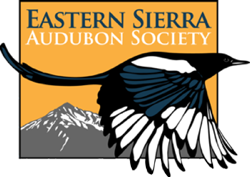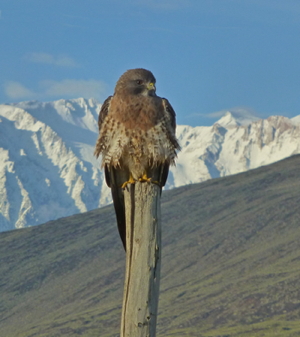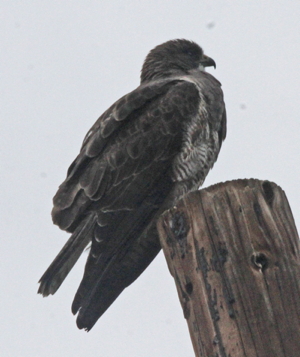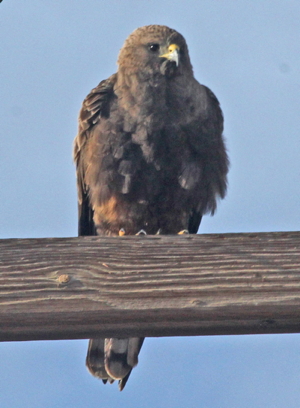Swainson's Hawk - An Amazing Migratory Event in Inyo County
When the dawn's early light begins to awaken people, they seldom wake up thinking, "Today I am going to see an amazing avian event!" Those who experienced this event, one that had never been recorded in the Eastern Sierra before, had no premonition that this day was the day!
On 9 April 2016 in the afternoon, an email, via the Eastern Sierra Birds website sent by Chris and Rosie Howard, alerted the world that they were in the middle of more Swainson's Hawks than they had ever seen before. They carefully counted the birds sitting on the sprinkler lines or on the ground on the alfalfa fields plus a few birds flying above the fields along Steward Lane, southeast of Big Pine and came up with 57 and 59 birds! All the important work that people were doing was no longer as important as "flying" to the alfalfa fields!
The previous Inyo County maximum count for Swainson's Hawk was 34 birds with two records in the 1990s. First, was a group of one year–old birds photographed in the same Steward Lane alfalfa fields 19 June through 4 July 1990 (Tom & Jo Heindel, American Birds 45:1161) and the second group was in the Inyo County portion of Fish Lake Valley on 11 September 1998 (Jon Dunn, pers. comm.). The June birds were late migrants who were not going to breed that year and the September birds were during the peak of fall migration.
Excitement was high as observers rushed to see this group that was almost double the old record! Little did they know! Swainson's Hawks are known to migrate in large numbers with 200 and more birds recorded often in southern California but these groups have NEVER been recorded in the eastern Sierra Nevada area. Inyo County records extend from late March to mid October with most movement detected in April when the birds move north from their main wintering grounds in Argentina to their breeding areas in the western US and into southern Canada. In fall they move through the eastern Sierra Nevada from late August to early October with most passage in September. They are uncommon breeders in Inyo County.
Because we had been working on our computers that afternoon, we received the Howards' post instantly and were out the door with binoculars and cameras in a few minutes. As soon as we turned onto Steward Lane we began counting perched Swainson's Hawks and quickly passed the previous records of 34 birds. Shortly, with 94 Swainson's tallied, we joined Chris & Rosie on a dirt road along the east margin of the alfalfa fields and learned that their count was now 110 birds! Over three times the previous maxima!! Only a few Swainson's were in the air, so a 360° transect with scopes on the distant irrigation pipelines, fence posts, and trees and binocular views of the ground efficiently and effectively arrived at a fairly accurate count of what was in view from one square foot of ground! We departed to attend to business while the Howards continued south to check other nearby fields and other birders began arriving to the posted location.
The timing of this event was during the departure of a storm, moving north, with occasional sprinkles that dampened us as we exited. We knew that it was too late in the day for a major migration to begin and heading north would move them up in elevation and into a more active part of the storm. Not a pleasant situation. We looked forward to returning the following morning.
We were at Steward Lane at 0645hrs with the sun peeking over the Inyo Mountains. The elevated perches were festooned with Swainson's Hawks, all adults, and in a variety of color morphs from pale to dark; we began counting. Almost every sprinkler pipeline was weighed down with Swainson's Hawks…it was impressive! After an hour of driving all the dirt roads circling the fields immediately south of the "Lane", we counted 165 Swainson's Hawks! We decided to follow the course that the Howards took the previous day and turned left off of Steward Lane onto the Big Pine Canal Road, where we found two more Swainson's and then across Hwy 395 into the Fish Springs area where we had an additional 15 Swainson's for a morning total in the Big Pine area of 182 birds! Over five times the previous maximum record!
This species exhibits a wide variety of plumages. Some birds are very light and others very dark with the majority somewhere in between. The underparts of some birds are rusty, others are barred, and other birds are very plain. In flight, the wings from below appear thinner and more pointed than the similar-sized Red-tailed Hawk.
This species occurs in huge numbers as they migrate south in fall through southern Mexico and Panama on their way back to Argentina. They rely on rising warm air over land to assist their flight and generally avoid air over water where it is cooler and not very supportive. As they travel south through Central America, the landmass becomes more and more narrow, forcing the birds to concentrate in order to avoid flying over water. In Veracruz and Panama, hundreds of thousands of Swainson's Hawks have been counted passing through narrow, funnel-shaped land areas where special hawk counting stations have been set up.
There is little doubt that all the observers of this recent event were the beneficiaries of the confluence of weather conditions with a wave of migrating Swainson's Hawks and a couple of local birders who realized the significance of their sighting and got the alert out right away. Our thanks to the Hawks and the Howards!
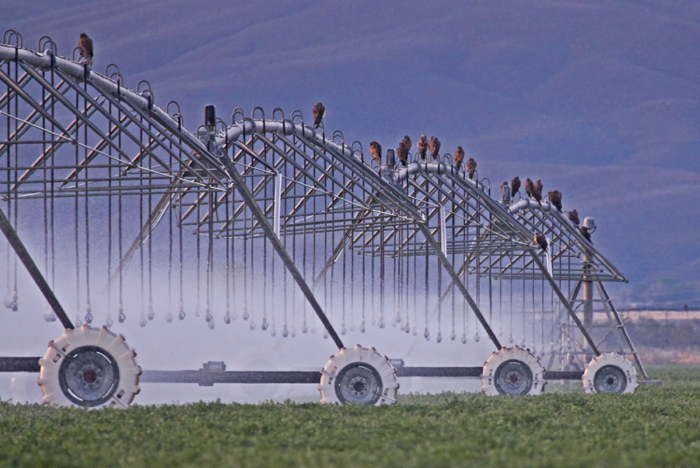
Swainson's Hawks lining up on the irrigation sprinklers - how many can you see? Photo by Tom Heindel
